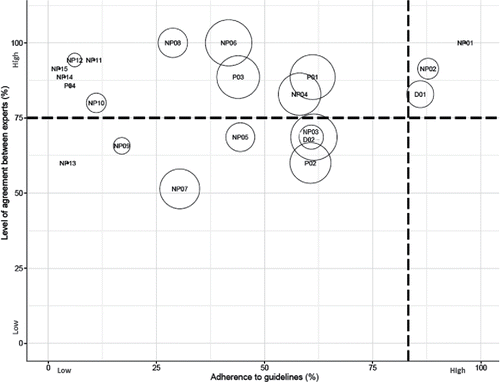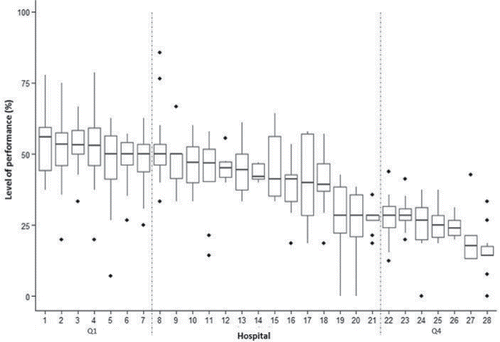Figures & data
Table 1. Patient and hospital characteristics.
Figure 2. Importance-performance analysis. The labels within the circles correspond with the process indicators mentioned in (D01, performance of arterial blood gases (ABG) measurement during first 24 hours of admission; D02, performance of chest X-ray during first 24 hours of admission; P01, prescription of antibiotics, P02, prescription of short-acting bronchodilators during hospitalisation, P03, prescription of long-acting bronchodilators during hospitalisation; P04, prescription of 30–40 mg of oral prednisolone daily for 7–10 days; NP01, administration of controlled oxygen therapy in patients hypoxemic during admission; NP02, assessment of smoking status, NP03, patient received influenza vaccination within the past year; NP 04, ABG measurement 1 or 2 days prior to discharge in patients hypoxemic during a COPD exacerbation; NP05, patient received pneumococci vaccination within the past five years; NP06, prescription of home oxygen therapy in patients with hypoxemic at discharge; NP07, nutritional assessment (BMI); NP08, referral to pulmonary revalidation during the past year; NP09, nutritional management of patients with overweight; NP10, adequate discharge management; NP11, education regarding inhaler therapy in patients in which inhaler therapy is prescribed; NP12, performance of revalidation tests during the past year (inclusive current hospitalization); NP13, nutritional management in patients with underweight; NP14, education regarding home oxygen therapy in patients in which home oxygen is prescribed; NP15, smoking cessation intervention in active smokers at admission). The horizontal line shows the high or low level of importance (75%), whilst the vertical line shows the high or low level of performance (80%). The larger the circle, the larger the IQR. The highest IQR, Q3–Q1, and shown by the largest circles, was noticed for D02, performance of chest X-ray during first 24 hours of admission, and NP06, prescription of home oxygen therapy in patients with hypoxemic at discharge. The lowest IQR, shown by the smallest circle, was noticed for NP12, performance of revalidation tests during the past year.

Table 2. Overview process indicators for the in-hospital management of a COPD exacerbation.
Figure 3. Adherence to guidelines at hospital level. The figure gives an overview of the variation between and within hospitals according to adherence rate to guidelines. On the left side, the hospital with the highest median score on the adherence rate to guidelines is mentioned, whilst on the right side, the hospital with the lowest median score is mentioned. The vertical lines show the first and fourth quartiles.


